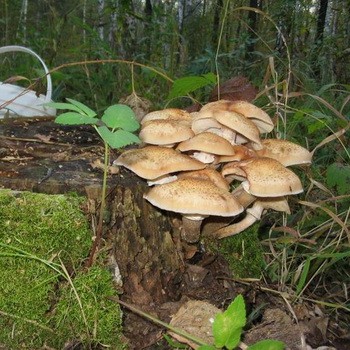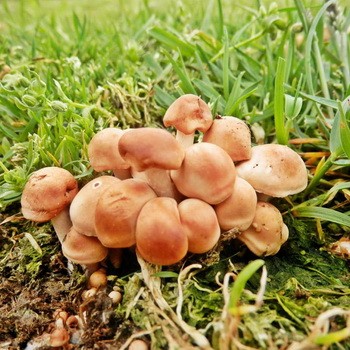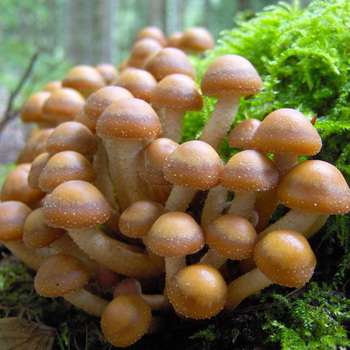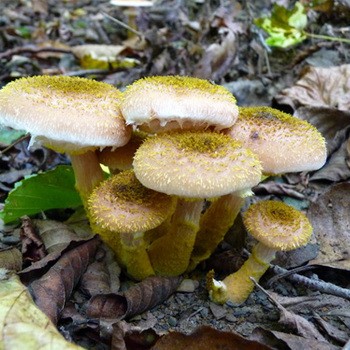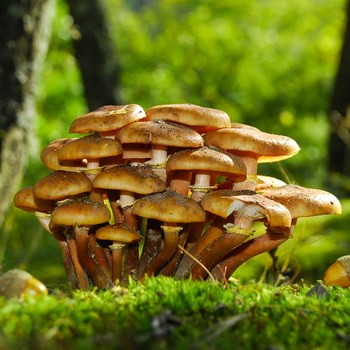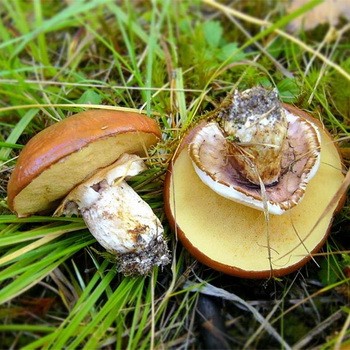Edible and false mushrooms growing on trees.
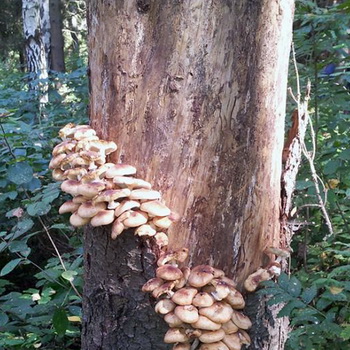
If honey mushrooms can mainly be found on stumps, then the question arises: do honey mushrooms grow on trees? Translated from Latin, the word "wrap" means "bracelet". This name is not surprising, because in addition to stumps, these fruiting bodies grow on diseased and dying trees, growing in a circle. To find such mushrooms in the forest is not difficult at all, especially if there are often a lot of them in one area.
Content
Edible mushrooms mushrooms that grow on living trees (with photo)
Honey mushrooms have thin, flexible and long legs, reaching 10, and sometimes 15 cm in height. Its color ranges from light honey to brown, depending on the soil and trees on which the mushrooms grow.
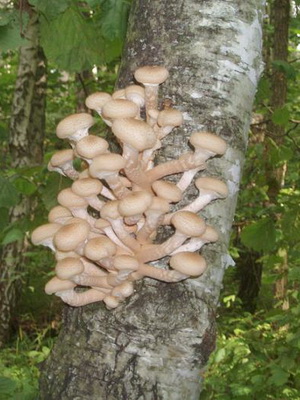
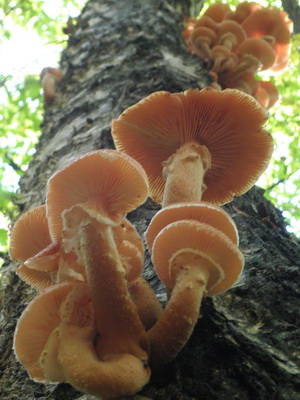
Pay attention to the photo of edible mushrooms growing on trees. It is shown here that each instance has a film skirt ring. She frames the legs of honey agarics at a young age, and in adulthood, the skirt is torn and hangs with "rags." Hats of real mushrooms in a hemispherical shape are covered with small scales. The color of the hats varies from cream yellow to red.
Mushrooms mushrooms growing on a tree are known to all lovers of "silent hunting", because they are able to capture large areas under their natural habitat. It often happens that even on living trees honey agarics feel great. In addition, they can be found near some species of shrub plants, for example hazel, in meadows, forest glades, in ravines and in raw alder.
For beginner mushroom pickers, we suggest looking at a photo of mushrooms mushrooms that grow on trees:
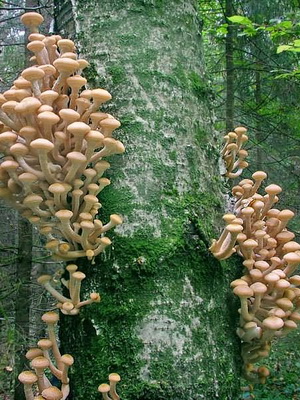
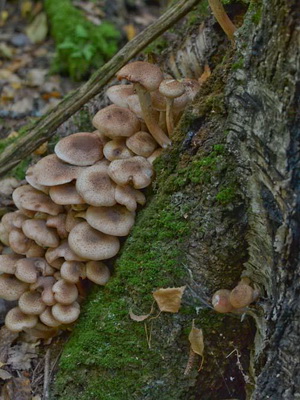
However, these fruiting bodies are often found in deforestation, for example, under power lines. There, almost every stump is dotted with large groups of honey agarics. On the stumps of which trees do honey mushrooms prefer to grow? These fruiting bodies are found throughout Russia, including the Northern Hemisphere and the subtropic zone. Honey mushrooms do not grow only in the harsh areas of eternal ice. A big advantage is the rotten stumps of birch, alder, aspen and oak. But other tree species are also in demand among honey agarics, for example, acacia and even fruit trees.
What trees are edible mushrooms growing on and what do they look like?
Edible mushrooms are divided into spring, summer, autumn and winter species. Let us specifically note on which trees edible mushrooms grow. Spring and summer mushrooms are mainly distributed on deciduous trees, trunks with damaged and rotten wood are especially preferred. And in mountainous areas, summer mushrooms are found on spruce and spruce stumps. Honey mushrooms growing on conifers have a bitter taste and dark color, although this does not affect their nutritional value.Summer mushrooms have a leg up to 7 cm high and a diameter of 1 cm. The lower part of the leg is covered with dark small scales. The "skirt" around the leg is narrow with some steep edges.
In the deciduous forests of the temperate zone of Russia, you can collect summer mushrooms from April to August. In a favorable climate, this species can bear fruit without interruption. Since summer honey agarics have false counterparts, experienced mushroom pickers advise collecting them only on the remains of deciduous trees, and preferably only on stumps left after cutting birches.
The most popular among honey agarics is considered the autumn species, which is known as the "real honey agaric", "autumn flock" or "assumption honey agaric". Mushroom pickers with experience are happy to share information on which trees autumn mushrooms grow on. This species begins its growth in August and continues almost until November. Most often it prefers birch and birch stumps, then aspen, maples and oaks. Usually, autumn mushrooms choose trees that show signs of rotting or disease. Although sometimes these mushrooms can even choose a living tree. Especially the expanse for them are old birch forests with fallen trees or swampy birch forests with many rotten trunks and stumps.
Do mushrooms grow on conifers?
Autumn conifer mushrooms are much less common on conifers, although their beneficial properties and vitamins are not inferior to honey mushrooms growing on deciduous trees. These mushrooms can sometimes choose pine and spruce, as well as their stumps.
It is worth saying that almost all species of honey agarics are considered parasites of the forest, since almost 200 species of tree species are affected. Young trees can die from honey agarics in just 3-4 years, adults in 8-10 years. And if honey agarics fall on a garden plot, it can greatly harm fruit trees. Spores of honey agarics grow very quickly on the surface of fresh stumps. Under the bark, a mycelium begins to develop and destroy wood. Honey agarics are able to switch to nearby trees and kill living tissue with their toxins. Therefore, honey mushrooms that grow on trees are cut, the tree is cut down, and the stump is pulled out from under the ground. If it is not possible to remove the stump, it is lubricated with machine oil once every six months.
Despite the fact that honey agarics are a parasitic fungus, they are very tasty and healthy. When eating honey mushrooms in the human body, the metabolism is normalized. The body receives a sufficient amount of calcium, magnesium, iron, phosphorus and potassium. A special sign of edible mushrooms that grow on trees and stumps is a glow in the dark. If you are not too lazy to look at honey mushrooms at night - the bottom of the caps of these mushrooms, as well as the threads of the mycelium, glow with a gentle glow.
Autumn honey agarics are the largest representatives of their kind, since their hat in diameter reaches 15-17 cm. In the middle of the hat there is a convex tubercle, and small scales are brown on the surface. The skirt framing the leg comes off over time and forms a veil hanging under the hat. Sometimes during the dry summer months, autumn mushrooms are found even on drying deciduous trees at an altitude of about 2-3 m from the ground. Therefore, you need to have a large stick with a hook with you to collect these fruiting bodies.
In the beginning of June, edible meadow mushrooms appear, flashing yellow-brown among the tall grass in the fields, pastures, along forest paths and in ravines. As you have noticed, meadow mushrooms do not grow on the tree, preferring the land.
The end of September and the beginning of October is notable for the fact that the season for collecting winter mushrooms begins. These fruiting bodies grow in families that grow together with legs on fallen poplars, maples, willows, aspen, and also on their stumps. Winter mushrooms are harvested all fall before the onset of severe frosts. It is noteworthy, but these mushrooms do not disappear in winter, but simply “fall asleep”. During thaws, almost until April, they continue to grow.
Winter mushrooms on the trees look like a bright red or orange spot. In the winter forest, such mushrooms are very easy to see even from a distance.They do not have false counterparts due to their late bearing. Although winter mushrooms are considered to be a conditionally edible mushroom, many mushroom pickers call it the most delicious. In addition, winter mushrooms are the best for growing at home.
Do false mushrooms grow on trees and photos of mushrooms
However, autumn and summer honey agarics have false doubles. Many are interested in the question: do false mushrooms grow on trees? The danger of these mushrooms is that they can grow next to edible species, one might say, right on one stump or tree. Therefore, if you find a family of honey mushrooms, carefully look to see if there are any false ones. The main difference is the "skirt" on the leg, which is peculiar only to edible mushrooms. Poison mushrooms have a wormwood taste and a disgusting smell resembling a cadaveric one.
Gathering mushrooms is a very hazardous occupation, since there is a risk with edible mushrooms to bring home in the basket and false. Therefore, before going on a “silent hunt”, refresh all the necessary differences in your memory in order to be able to recognize poisonous doubles. We offer you to see photos of false honey mushrooms growing on a tree, which at first glance are very similar to real ones:
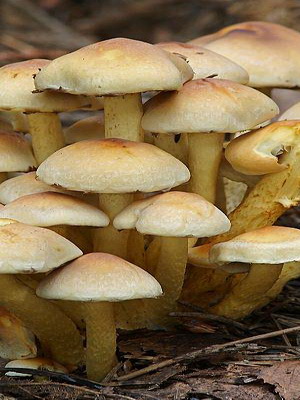
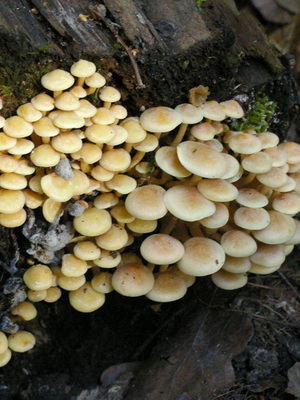
Another point that novice mushroom pickers need to remember is not to collect mushrooms near industrial plants or directly at highways. In this case, even edible mushrooms can lead to poisoning and harm to health.

